JARS v53n2 - George Fraser: His Friendship with Joseph Gable and His Hybrids
George Fraser: His
Friendship with Joseph Gable and His Hybrids
Bill Dale
Sidney,
British Columbia
Canada
In 1985, three of us, Dr. Stuart Holland, Miss Frances Gundry, and myself, undertook to research and record the life and work of George Fraser of Ucluelet, British Columbia. By 1988 we figured that we had completed our work, which we compiled into a booklet of 82 pages of which we made about a dozen copies and distributed them to people whom we knew to be interested in this pioneer plantsman.
Sadly, in 1989, Dr. Holland died after a brief illness of cancer and our work was put aside after being deposited in the British Columbia Provincial Archives in Victoria, B.C., and with the Ucluelet and Area Historic Society.
During our years of research, I had received several letters from Joseph Gable's daughter, Caroline, a great admirer of Fraser, who had helped her father, especially in his first few years of growing rhododendrons. Joseph Gable became the dean of all American rhododendron hybridizers and, besides all of the other honours which were bestowed on him, was the first recipient of the prestigious American Rhododendron Society Pioneer Achievement Award. Gable saved the letters he received from Fraser, and in 1960 sent them to British Columbia where he thought they should be kept for future reference by rhododendron people. Frances Gundry put them into the British Columbia Provincial Archives in Victoria for safe keeping along with other information we collected. There were 62 letters in all from Fraser to Gable and copies were sent to Caroline who later gave them to the Joseph Gable study group, after which they were given to the Alderman Library in Virginia. These letters of course were full of information about rhododendron growing. Fraser, who was a bachelor, also took a great deal of interest in Gable's family. Caroline told me that each Christmas Fraser would send a parcel to Mrs. Gable, recalling the great excitement in the Gable household when Mr. Fraser's parcel would arrive. It always contained holly and pernettya for decorating their home. Fraser and Gable had great respect for each other and during the 20 plus years of their correspondence each addressed their letters to "Mr. Gable" and "Mr. Fraser."
In a letter dated Jan. 8, 1942, from Gable to Guy Nearing, he said, "I first had a Christmas note from Mr. Fraser of Ucluelet, Vancouver Island, who first introduced me by mail to Mr. Magor. So to these two men - more than all others, almost to the exclusion of all others - I owe my acquisitions in the first few years of my rhododendron growing." On Dec. 10, 1931, Gable wrote to Nearing saying, "Mr. Fraser of B.C., an old hybridist - alas growing old as we all must." On April 23, 1943, Gable wrote to Nearing, "I sure wish he (Fraser) was young again and could go along with us as he would most wholeheartedly do." Fraser would live another 13 years dying in 1944 in his ninetieth year.
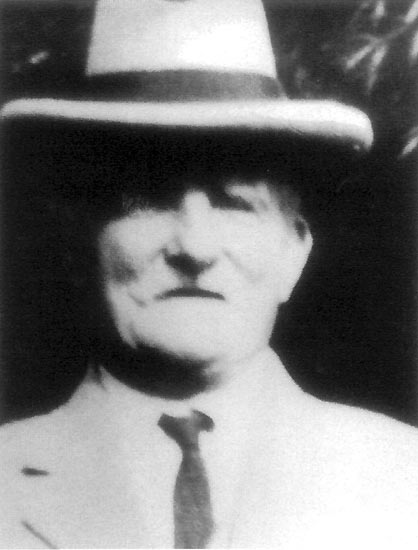
|
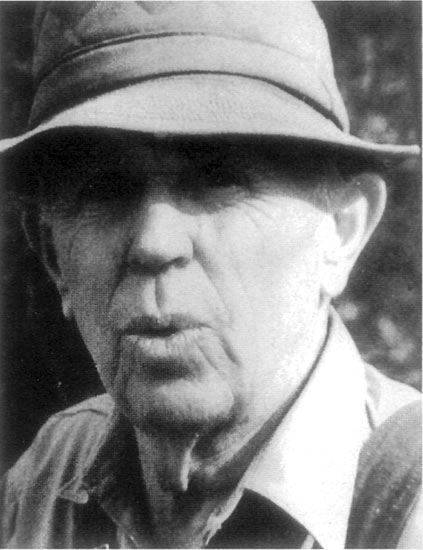
|
|
|---|---|---|
George Fraser |
Joseph Gable |
Below are a few excerpts from a letter of Nov. 8, 1960, from Joseph Gable to Clive Justice of Vancouver, B.C., which express Gable's thoughts of George Fraser:
"Mr. Fraser helped me very much in my earlier years, and I owe very much of what I have been able to accomplish to him.
"My first hybrids of R. fortunei , R. discolor [now classified as R. fortunei ssp. discolor ] and perhaps too of R. decorum were obtained through the Magor-Fraser channel and much of my work has been basically built up from these crosses.
"So both I and those who grow and enjoy the varieties of rhododendrons I have concocted and disseminated owe a debt we can not figure in dollars and cents to the kindly paternal advice and generosity of my old friend George Fraser."
In the spring 1998 issue of the ARS journal, I learned of Caroline's death. In this same issue was an article by Clive Justice on finding Rhododendron Fraseri Group growing at the Mustila Arboretum some 80 kilometers northeast of Helsinki, Finland. Also last spring Fred Collins of Cobble Hill, B.C., showed me a Fraser hybrid of which I was unaware. These three occurrences prompted me to write this very brief account of some of Fraser's hybrids. I say "some," as it is evident from his letters to Gable that he hybridized many others than those we know about.
Bear in mind that Fraser died at age 90, in 1944, the year that the ARS was founded. Much of our information comes from his letters as well as from making assumptions, as we know that he exchanged pollen, seed, and even plants with Gable in Pennsylvania and E. J. P. Magor of Cornwall.
R. Fraser Group
R. canadense x, R. molle, ssp. japonicum. This cross bears flowers of a pleasing shade of rose-lilac. It took Fraser 23 years to develop this most famous of his hybrids, which would be named by Mr. William Watson, curator of the Royal Botanic Garden, Kew. Simultaneously but quite independently it would be given the same name by Dr. E. H. Wilson of the Arnold Arboretum in Boston.
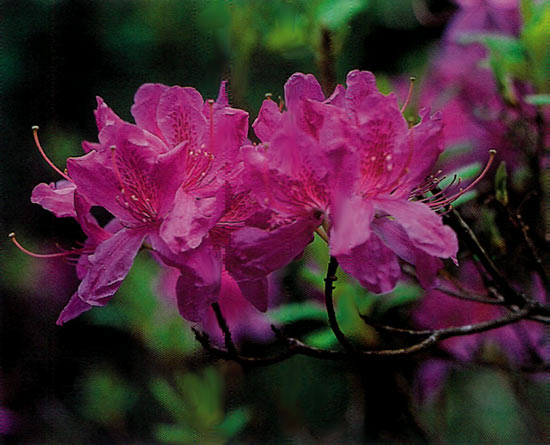 |
|---|
R. Fraseri Group Photo by Bill Dale |
R. 'Albert Close' (R. maximum x 'Mrs. Jamie Fraser'). Fraser sent seed of this cross to Gable who grew several of them. Gable described the flowers as medium size, bright rose-pink with throat heavily spotted chocolate red. Gable named one of these seedlings 'Albert Close' for the chief propagator at the U.S. Department of Agriculture Plant Introduction Station at Glenn Dale, Maryland.
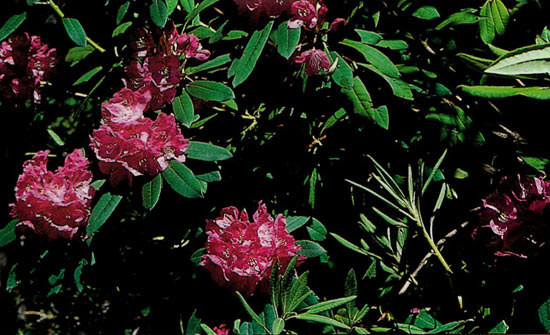 |
|---|
R. 'Albert Close' Photo by Bill Dale |
R. 'George Fraser' (R. macrophyllum x maximum). This is another of Fraser's hybrids of which he sent seed to Gable. Gable wrote, "Obviously the seeds from which these hybrids were grown contained a lot of plain R. maximum and some 10-20% hybrids. In a thicket of R. maximum 10 to 12 feet high, I noticed a fine pink truss of flowers. Since the flower was so fine I immediately cut, dug, and tore all branches of R. maximum away. Since when it has developed amazingly." It is described by Gable as being light red, late, hardiness -10F, and a shy bloomer. There are only two truly authentic plants of 'George Fraser' known to exist. One of these is growing in the original garden of Joseph Gable in Stewartstown, Pa. The other was discovered in the Gable section of the Tyler Arboretum at Lima, Pa. There Dr. Franklin West came across a huge plant of 'George Fraser' that Dr. John Wister had bought from Gable in the 1950s. In 1990 Dr. West sent cuttings from this plant to Lynn Watts of Bellevue, Wash., who rooted them. One of these plants was given to the VanDusen Botanical Garden in Vancouver. The other is in my garden in Victoria.
R. 'Maxie' (R. maximum x R. macrophyllum). Gable states, "Pink with heavy spotting, very late, from Fraser seed, named by Gable."
R. 'Fraser No. 3'* (R. macrophyllum x R. maximum). In Hybrids and Hybridizers edited by Philip Livingston and Franklin West, on page 89, Gable states, "Colour pink, late bloom period, hardiness to -15F. Cross by Fraser (named by Gable). No plants of this are now known.
R. 'Camich' (R. catawbiense x 'Michael Waterer'). Fraser
made the cross and sent seed to Gable who named one of the seedlings 'Camich'.
He described it: "Cerise red, bloom period mid-season, hardiness to -15F,
floriferous, very slow growing." Gable stated that he had selected two to keep - the
two that were the darkest coloured flowers, a deep red-purple.
A few years ago, Caroline Gable told me that a plant of 'Camich' was growing in
a yard in Stewartstown which was due to become part of a development. She arranged
to have the plant moved to the Gable homestead. She sent me a picture of it in bloom
prior to its being moved. I have not heard whether the plant survived the move.
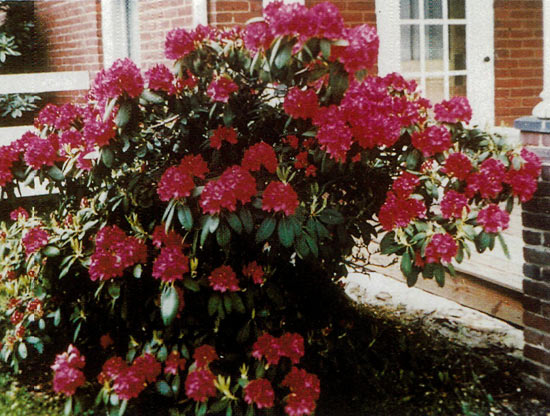 |
|---|
R. 'Camich' Photo by Bill Dale |
R. John Blair Group (R. occidentale x R. arborescens). This cross was made by Fraser in 1922-1924. In the 1964-1965 catalogue of Eddie's Nursery, Vancouver, it is described as "[the grex] being similar in size and shape, flowers pure white and produced in late spring to 7 feet." There are only three plants of this grex which Fraser had named in honour of his friend John Blair for whom he had worked as foreman when Blair designed and built Beacon Hill Park in 1889. Two of these plants are in the garden of Mrs. Art Baird of Ucluelet. The third Mrs. Baird gave to me, and I have it growing in my garden at Sidney where late in the spring it spreads its spicy fragrance. In 1990 I registered my plant with the ARS as R. 'John Blair'. I have not yet been able to propagate it but am trying very hard to do so.
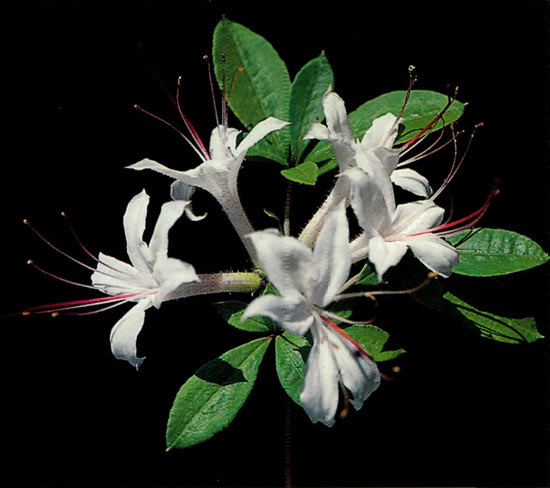 |
|---|
R. John Blair Group Photo by Bill Dale |
R. 'Mrs. Jamie Fraser' [(R. arboreum x R. macrophyllum) x R. arboreum]. In Hybrids and Hybridizers in a letter dated Jan. 30, 1931, Gable wrote to Guy Nearing: "Fraser grows a hybrid that is so dark it is almost black, judging from the dried flowers he sent me. He claims it is the darkest shade he ever grew and calls it 'Mrs. Jamie Fraser' after his sister-in-law. The colour of the bloom is a moderately deep toned blackish crimson with a flare of black spots in the throat. The only specimen known to exist was identified in 1987 in the garden of Mr. and Mrs. Ken Gibson in Tofino, B.C. Ken had salvaged the specimen from the area behind Wickananish Inn near Ucluelet when the walks were being replaced. It now grows happily beside a stump in the Gibson's garden in Tofino. It has been successfully propagated by the Jeffersons in their nursery at Qualicum Beach, B.C.
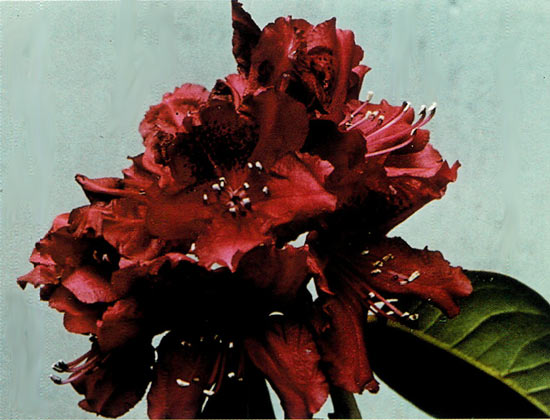 |
|---|
R. 'Mrs. Jamie Fraser' Photo by Bill Dale |
Unnamed Fraser hybrid (located in Fred Collins' garden at Cobble Hill, B.C.). I recently came across this Fraser hybrid in Fred Collins' garden at Cobble Hill. It arrived there by a rather circuitous route. This is another of Fraser's hybrids the origin of which is obscured but which Gable most likely had a hand in. It closely resembles Rhododendron minus which is native to the Appalachian Mountains which run through Gable's home state of Pennsylvania. It is likely that Gable sent Fraser either pollen or seed from there. What he crossed it with is unknown, but is most likely R. macrophyllum. Apparently he sent a plant from this cross to the Strybing Arboretum in San Francisco. Jock Brydon became director of Strybing in 1960. Some time after that Ben Nelson of Rosedale, B.C., was in San Francisco on a buying trip and Brydon gave him this plant as he figured it should be growing in British Columbia. Nelson was not a rhododendron man so gave it to Fred Collins of Maple Ridge who was. Fred has moved a few times since but always moved the plant with him. It is growing happily in his garden in Cobble Hill and has layered itself. Fred very generously gave me one of these layers.
Bud Thompson, who was a friend of Fraser, took care of him during his last days. When
it came time for Fraser to leave his cabin and go to the hospital, a speed boat was
brought to the beach in front of his cabin, and he was carried to it. He turned to his
friend Bud Thompson and said, "I don't know where I'm going to end up, but it really
doesn't matter as I've had my heaven here on earth. He died five days later, on May 5,
1944.
George Fraser was the fourth recipient of the ARS Pioneer Achievement Award.
 |
|---|
R. 'Caroline Gable' Photo by Bill Dale |
Now in my garden I have among my collection of Fraser hybrids: Fraseri Group, 'Albert Close', 'George Fraser', John Blair Group, 'Mrs. Jamie Fraser', and the unnamed Fraser hybrid in the Collins garden. Among them too is my plant of R. 'Caroline Gable'. I'm hoping to get a cutting of R. 'Camich'. I'm hoping also that someone or some ARS Chapter might be willing to see that these hybrids of this outstanding hybridizer will not be lost. In the spring 1998 issue of the Journal, Sandra McDonald of Hampton, Va., noted that she had seen the Fraser letters in the Alderman Library at the University of Virginia. His letters are in a secure place. Let's hope that his hybrids can be also.
* Name is unregistered.
Bill Dale is a member of the Cowichan Valley Chapter. He would appreciate getting a cutting of 'Camich' should anyone have this plant.
by Chase Dooley
